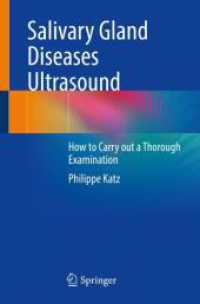- ホーム
- > 洋書
- > 英文書
- > Science / Mathematics
Full Description
As its name suggests, the 1988 workshop on "Interacting Electrons in Reduced Dimen the wide variety of physical effects that are associated with (possibly sions" focused on strongly) correlated electrons interacting in quasi-one- and quasi-two-dimensional mate rials. Among the phenomena discussed were superconductivity, magnetic ordering, the metal-insulator transition, localization, the fractional Quantum Hall effect (QHE), Peierls and spin-Peierls transitions, conductance fluctuations and sliding charge-density (CDW) and spin-density (SDW) waves. That these effects appear most pronounced in systems of reduced dimensionality was amply demonstrated at the meeting. Indeed, when concrete illustrations were presented, they typically involved chain-like materials such as conjugated polymers, inorganic CDW systems and organie conductors, or layered materials such as high-temperature copper-oxide superconductors, certain of the organic superconductors, and the QHE samples, or devices where the electrons are confined to a restricted region of sample, e. g. , the depletion layer of a MOSFET. To enable this broad subject to be covered in thirty-five lectures (and ab out half as many posters), the workshop was deliberately focused on theoretical models for these phenomena and on methods for describing as faithfully as possible the "true" behav ior of these models. This latter emphasis was especially important, since the inherently many-body nature of problems involving interacting electrons renders conventional effec tive single-particle/mean-field methods (e. g. , Hartree-Fock or the local-density approxi mation in density-functional theory) highly suspect. Again, this is particularly true in reduced dimensions, where strong quantum fluctuations can invalidatemean-field results.
Contents
I. Methods.- A. Solvable Models and Analytic Results.- Brief History of a One-Dimensional Ground State Wave Function.- Two Theorems on the Hubbard Model.- A Model of Crystallization: A Variation on the Hubbard Model.- The Fermi-Linearized Hubbard Model: Dimer Ground State.- Superconductivity of Itinerant Electrons Coupled to Spin Chains.- Valence Bond Spin Models: Ground States and Excitations.- B. Quantum Monte Carlo and Numerical Diagonalization Methods.- Numerical Simulation of the Two Dimensional Hubbard Model.- Stable Matrix-Multiplication Algorithms for Low Temperature Numerical Simulations of Fermions.- Numerical Simulations of the Two-Dimensional Hubbard Model.- Monte Carlo Simulation of a Three-Band Model for High-Tc Superconductors.- Exact Valence-Bond Approach to Quantum Cell Models.- Lanczos Diagonalizations of the 1-D Peierls-Hubbard Model.- C. Variational and Perturbation Theoretic Methods.- Variational Wave Functions for Correlated Lattice Fermions.- Variational Approach to Correlation Functions and to the Periodic Anderson Model in Infinite Dimensions.- The Hubbard Model in Infinite Dimensions.- Correlation Functions for the Two-Dimensional Hubbard Model.- D. Density Functional Theory.- Density Functional Calculations for Strongly Correlated Systems.- Dimensionality Effects in trans-(CH)
x.- II. Quasi-One Dimensional Models and Materials.- A. Applicability of Hubbard-Type Models.- The Hubbard Model for One-Dimensional Solids.- Off-Diagonal Coulomb Interactions in the Extended Peierls-Hubbard Model: Exact Diagonalization Results.- Electron Correlation and Peierls Instability.- B. Organic Conductors and Conjugated Polymers.- Instabilities in Half-Filled One-Dimensional Systems: Valence Bond Analysis.- Quantum Monte Carlo Study of Neutral-Ionic Transition.-Diagonal and Off-Diagonal Electronic Interactions and Phonon Dynamics in an Extended Model of Polyacetylene.- Phonons and Quantum Fluctuations in a Dimerized Electron-Phonon Chain.- Scaling Approach to Electronic Correlations in Organic Conductors.- Peierls Instability in Weakly Non-Ideal One-Dimensional Systems.- Use of the Spin Hamiltonian to Study the Spin-Peierls Instability and Magnetism in Conjugated Polymers.- A Two Band Model for Halogen-Bridged Transition Metal Linear Chain Complexes.- Numerical Simulation of a One Dimensional Two Band Model.- Disordered Quantum Spin Chain and its Relevance to the Disordered Superconductor.- 1/n Expansion for Quantum Heisenberg Antiferromagnets.- III. Quasi-Two Dimensional Models and Materials.- Fractional Quantum Hall Effect: Recent Developments.- Fröhlich Conduction of Spin Density Waves in Quasi-Two Dimensional Systems.- A Unified Theoretical Approach to Superconductors with Strong Coulomb Correlations: The Organics, LiTi2O4, Electron- and Hole-Doped Copper Oxides and Doped BaBiO3.- Spin Fluctuations and Quasiparticles in Cu-O Planes.- Electronic Properties and Spin-Correlations of CuO2-Planes in High Temperature Superconductors.- Numerical Approach to Magnetic Mechanism of Superconductivity.- Parastatistics for Highly Correlated Two Dimensional Fermi Systems.- Composite vs Constituent Particle Aspects of Hole Motion in the CuO2 Plane.- S Pairing by Double Excitation of Triplet in Two Band System with Intermediate Electron Correlations.- Fermi Liquid Theory for High Temperature Superconductors.


![Gero×あらき×DECO*27/Gero 10周年記念アルバム THE ORIGIN[初回限定盤B]](../images/goods/ar/web/vimgdata/4550510/4550510080246.jpg)




